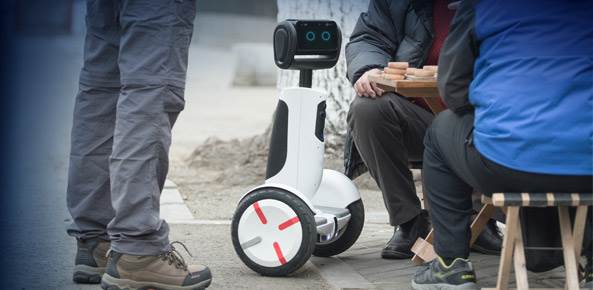If hoverboards were the big thing in 2015, this year might just become the year of the transforming robot. And the company that brings it to us may be Segway, better known for its iconic personal transportation vehicles beloved by mall security guards and walking tour companies.
Segway introduced an autonomous robot called the Segway Advanced Personal Robot this week at CES 2016 in Las Vegas. The robot is the result of a collaboration between Segway, Intel, and Xiaomi, a Chinese tech company. Xiaomi was one of the investors that contributed to $ 80 million in financing that Segway raised last year when it was acquired by its Chinese competitor Ninebot.
Transform and Roll Out
The new robot looks more like an average hoverboard than a Segway. In fact, the base model is just a robotic head attached to the center pole of the hoverboard the company released after it had been acquired. The company said the new device was “a Segway that sees the world and a robot that gives you a ride.”
Although details are still a bit sketchy, the company described the robot as a hoverboard that you can ride, and that can then follow behind you once you get off. It can also accept voice commands and features a number of physical extensions that can be added to increase its functionality, such as robotic arms.
The result is something of a robot butler that can carry items while it’s following you, or complete autonomous tasks, a bit like a version of Star Wars’ BB-8 app-enable droid that you can ride.
3D Tracking and Following
The company seems to be still exploring the different use cases and applications for the new platform; it plans to release a developer edition in the third quarter of this year complete with a full SDK (software development kit).
In terms of specifications, the Advanced Personal Robot has all the features of the Ninebot Segway released last year, including 800-watt double motors, a top speed of 18 km/h, and a maximum range of 30 km/h for a single trip. Including the robot head adds an Intel Atom processor, a depth-sensing camera, a fisheye tracking camera, and a photo camera to the mix.
The depth-sensing camera is an Intel RealSense RGB-D which, when used in combination with its other multiple cameras and sensors, gives the robot the ability to recognize and track objects in three dimensions. That’s important for when users want to hop off and have their robots follow them around.
The platform will also let users connect to other smart hardware and Internet of Things-enabled devices. That could be useful for allowing their robots to interact with other household appliances. Meanwhile, a microphone array lets the user issue voice commands from anywhere within the room, and interface extensions open up the possibility of adding arms or other devices to increase the robot’s functionality.






